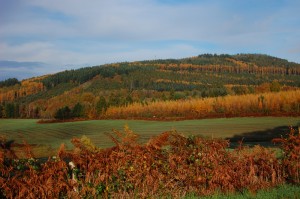 One of the great things about living in a climate that enjoys distinct seasons is how the changes affect the look of the surrounding landscape. Sometimes the changes are so dramatic, and take place over such a short period of time, that it feels like you have awoken to an entirely new environment.
One of the great things about living in a climate that enjoys distinct seasons is how the changes affect the look of the surrounding landscape. Sometimes the changes are so dramatic, and take place over such a short period of time, that it feels like you have awoken to an entirely new environment.
The Larch is an interesting tree. It is a conifer, it has needles instead of broad, thin leaves found on decidous trees, but it is not evergreen. It is one of the rare conifers that shed its needles each autumn.
In these hills, conifers are grown in abundance, farmed, planted in regimental grids, harvested for big industry by large, efficient machines. Most of the trees planted are Douglas Fir, which creates vast areas of dark, sterile environment, whose grey-blue-green colours never change.
In amongst the Douglas, the Larch is planted in smaller rows. It is grown mostly for use as a building material, rather than paper pulp, its highly resinous timber making it ideal for weather-proof cladding that needs no treatment.
Not being particularly knowledgeable about trees, I have difficulty identifying Larch, particularly from a distance when interplanted with other conifers, at the times of year when all the trees are in leaf, and the hills are a riot of green.
However, on beautiful autumn mornings such as today’s, these difficulties disappear. Just before they are shed, the needles of the Larch turn a vibrant yellow. For a fleeting moment, the swathes of monoculture are broken up, and the warm colours form linking tendrils, reaching out to the surrounding decidous fire-glow.
